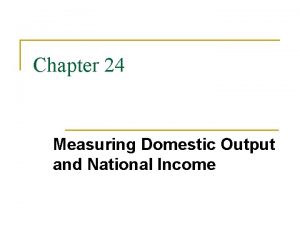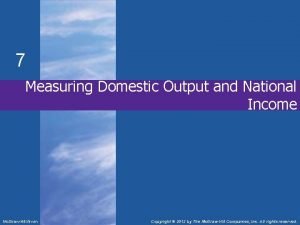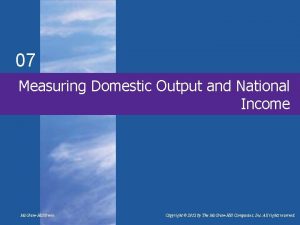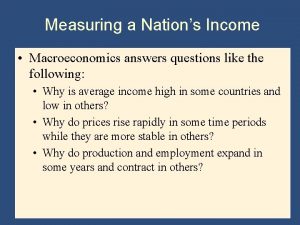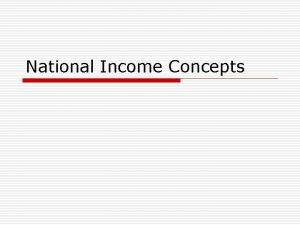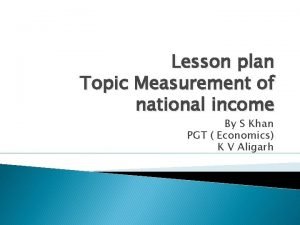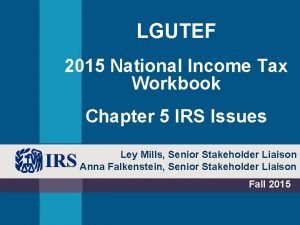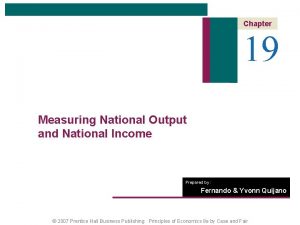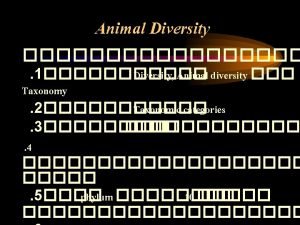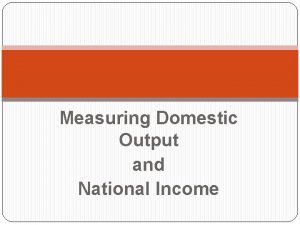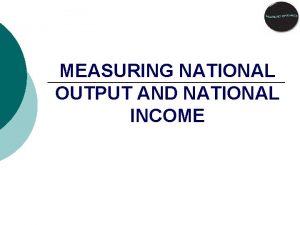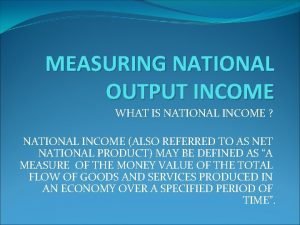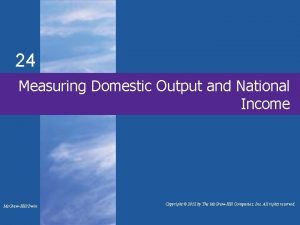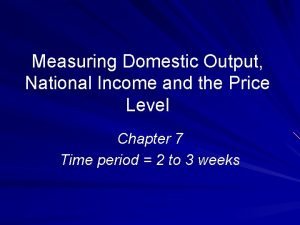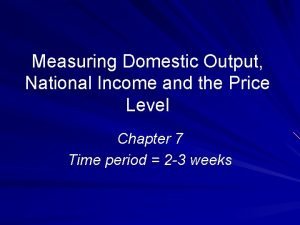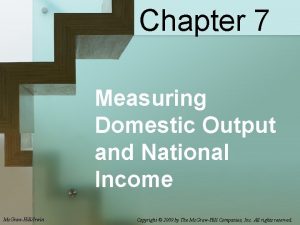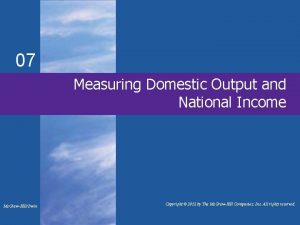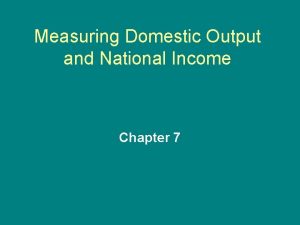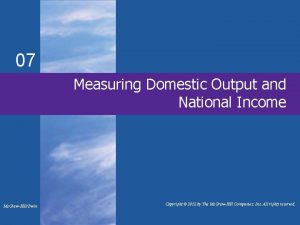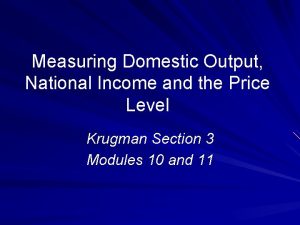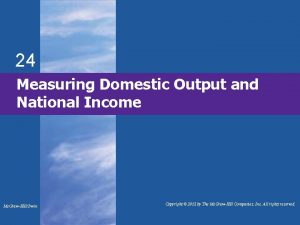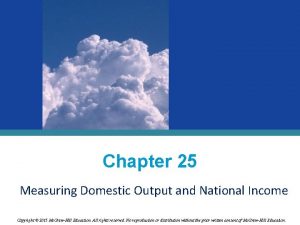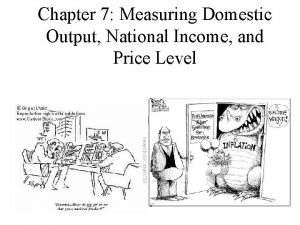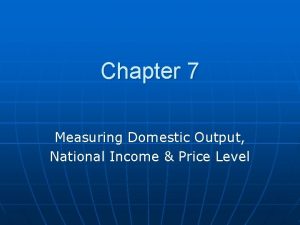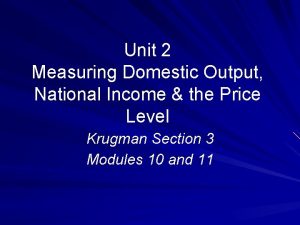7 Measuring Domestic Output and National Income Mc
























- Slides: 24

7 Measuring Domestic Output and National Income Mc. Graw-Hill/Irwin Copyright © 2012 by The Mc. Graw-Hill Companies, Inc. All rights reserved.

Assessing the Economy’s Performance • National Income Accounting • LO 1 • Assess health of economy • Track long run course • Formulate policy Gross Domestic Product (GDP): Total market value of all final goods and services produced within a country within a year

Gross Domestic Product • Monetary measure • Avoid multiple counting • Market value final goods • Exclude intermediate goods • Value added counted LO 1

Gross Domestic Product • Exclude financial transactions • Public transfer payments • Private transfer payments • Stock (and bond) market • LO 1 transactions Exclude second hand sales

Circular Flow RESOURCE MARKET • Households sell • Businesses buy BUSINESSES • buy resources • sell products HOUSEHOLDS • sell resources • buy products PRODUCT MARKET • Businesses sell • Households buy LO 1

Circular Flow Revisited LO 2

Two Approaches to GDP • Income approach • Count income derived from • LO 2 production Expenditure approach • Count sum of money spent buying the final goods

Two Approaches to GDP • GDP, output, and income all refer to the same thing and can be used interchangeably. LO 2

Expenditures Approach • Personal consumption expenditures • LO 2 (C) • Durable goods • Nondurable goods • Services • Spending on houses is not included Largest component of GDP

Expenditures Approach • Gross private domestic investment (Ig) • Machinery, equipment, and tools • All construction • Changes in inventories LO 2

Changes in Inventories Changes in inventories represent the difference between what was produced during the year, and what was purchased. LO 2

Changes in Inventories • If inventories increase, more was produced than purchased, so the increase in inventories must be added to Ig and GDP. • Vice versa if inventories fell. LO 2

Net Investment • Net Investment includes only added capital during the year. • In = Ig – Depreciation • Consumption of Fixed Capital (Depreciation) – amount of capital goods used during the year. LO 2

Net Investment • Ig > CFC; therefore In > 0 and economy is growing. • Ig = CFC; therefore In = 0 and economy is stagnant. • Ig < CFC; therefore In < 0 and economy is experiencing negative growth. LO 2

• • • LO 2 Expenditures Approach Government purchases (G) • Goods and services • Publicly owned capital • Excludes transfer payments Net exports (Xn) • Add exported goods • Subtract imported goods • Xn = exports - imports GDP = C+Ig+G+Xn

U. S. Economy 2015 in Billions Receipts Expenditures Approach Allocations Income Approach Personal Consumption (C)$12, 272 Compensation Gross Private Domestic Rents 657 Interest 524 Investment (Ig) 3, 021 $ 9, 655 Government Purchases (G) 3, 183 Proprietor’s Income 1, 388 Net Exports (Xn) Corporate Profits 2, 009 -529 Taxes on Production and Imports 1, 302 National Income $15, 535 Net Foreign Factor Income (-) Consumption of Fixed 214 2, 821 Capital (+) Statistical Discrepancy (+) Gross Domestic Product $ 17, 947 Gross Domestic Product -195 $ 17, 947 Source: Bureau of Economic Analysis, www. bea. gov LO 2

Comparative GDP LO 2

Other National Accounts • Net Domestic Product (NDP) • Measures what has been added to • LO 2 the stock of capital and the new output National Income (NI) • Includes all income earned by U. S. -owned resources whether they are located in the United States or abroad

Other National Accounts • Personal Income (PI) • Includes all income received • LO 2 whether it was earned or unearned Disposable Income (DI) • Income that households receive and able to spend as they desire DI = C + S

U. S. Income Relationships 2015 Gross Domestic Product (GDP) Less: Consumption of Fixed Capital Equals: Net Domestic Product (NDP) Less: Statistical Discrepancy Plus: Net Foreign Factor Income Equals: National Income (NI) Less: Taxes on Production and Imports Less: Social Security Contributions Less: Corporate Income Taxes Less: Undistributed Corporate Profits Plus: Transfer Payments Equals: Personal Income (PI) Less: Personal Taxes Equals: Disposable Income (DI) LO 2 $ 17, 947 2, 821 $ 15, 126 -195 214 $ 15, 535 1, 177 1, 203 530 591 3, 306 $ 15, 340 1, 945 $ 13, 395

Nominal vs. Real GDP • Nominal GDP • Uses current prices • Real GDP • Adjusted for inflation • Use base year’s prices LO 3

GDP Price Index • Use price index to determine real GDP Price Index In Given Year Real GDP LO 3 Price Good in Specific Year =Price of Good In Base Year x 100 = Nominal GDP Price Index (in hundredths)

Shortcomings of GDP • Nonmarket activities • Leisure • Improved product quality • The underground economy • GDP and the environment • Composition and distribution of the • LO 4 output Noneconomic sources of well-being

Underground Economy LO 4
 Measuring domestic output and national income
Measuring domestic output and national income Measuring domestic output and national income
Measuring domestic output and national income Measuring domestic output and national income
Measuring domestic output and national income Measuring domestic output and national income
Measuring domestic output and national income Personal income formula
Personal income formula Gdp vs gnp
Gdp vs gnp Measuring a nation's income
Measuring a nation's income 30% income tax
30% income tax Non operating income on income statement
Non operating income on income statement Loss contingency journal entry
Loss contingency journal entry The national income and product accounts
The national income and product accounts Gross national product tagalog
Gross national product tagalog National income concepts
National income concepts National income lesson plan
National income lesson plan National income formula
National income formula Lgutef
Lgutef Linear algebra
Linear algebra National income data
National income data What is national income
What is national income National income accounting equation
National income accounting equation National unification and the national state
National unification and the national state What is national output
What is national output Soil conservation and domestic allotment act
Soil conservation and domestic allotment act Soil conservation and domestic allotment act
Soil conservation and domestic allotment act The taxonomy of the domestic dog and humans
The taxonomy of the domestic dog and humans
